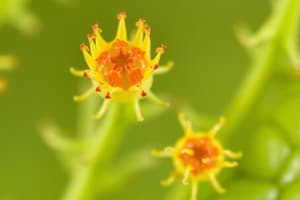Podcast
Questions and Answers
What is the primary function of collenchyma tissue in plants?
What is the primary function of collenchyma tissue in plants?
- To provide rigidity and support throughout the plant body
- To enable flexibility and support elongation in growing parts (correct)
- To store nutrients and water in mature organs
- To facilitate photosynthesis in green tissues
In which parts of the plant is collenchyma tissue primarily produced?
In which parts of the plant is collenchyma tissue primarily produced?
- In woody tissues of mature plants
- Shoot tips and young petioles (correct)
- Subterranean shoots and flowers
- Mature roots and older stems
What role do turgid parenchyma and collenchyma play in plant structure?
What role do turgid parenchyma and collenchyma play in plant structure?
- They function like air pressure and tire to provide stability. (correct)
- They work independently to support the plant.
- They primarily store water and nutrients for the plant.
- They enhance photosynthesis by increasing surface area.
Why is sclerenchyma tissue unsuitable for growing shoot tips?
Why is sclerenchyma tissue unsuitable for growing shoot tips?
What characteristic distinguishes sclerenchyma tissue from collenchyma tissue?
What characteristic distinguishes sclerenchyma tissue from collenchyma tissue?
What is the main characteristic of sclereids?
What is the main characteristic of sclereids?
Which type of sclereid is commonly referred to as stone cells?
Which type of sclereid is commonly referred to as stone cells?
What type of fibers are found in the xylem of plants?
What type of fibers are found in the xylem of plants?
Which type of sclerenchyma is responsible for conducting water in vascular plants?
Which type of sclerenchyma is responsible for conducting water in vascular plants?
What is the primary function of fibers in plants?
What is the primary function of fibers in plants?
Which type of fiber is most commonly found in phloem?
Which type of fiber is most commonly found in phloem?
Which type of sclereid is characterized by a star shape?
Which type of sclereid is characterized by a star shape?
Which of the following types of cells are typically found underneath the epidermis in young stems?
Which of the following types of cells are typically found underneath the epidermis in young stems?
What is the primary function of glandular hairs in carnivorous plants?
What is the primary function of glandular hairs in carnivorous plants?
Which of the following substances is typically exuded through hydathodes?
Which of the following substances is typically exuded through hydathodes?
What structural feature connects the cells of glandular hairs?
What structural feature connects the cells of glandular hairs?
What is the phenomenon called when water droplets are exuded from the edges of leaves?
What is the phenomenon called when water droplets are exuded from the edges of leaves?
What is the primary function of xylem tissue in vascular plants?
What is the primary function of xylem tissue in vascular plants?
In plants, what is the main challenge related to nutrient transport?
In plants, what is the main challenge related to nutrient transport?
Which structure in xylem helps facilitate the movement of water sideways?
Which structure in xylem helps facilitate the movement of water sideways?
What key characteristic allows xylem vessels to prevent collapse under pressure?
What key characteristic allows xylem vessels to prevent collapse under pressure?
Which type of xylem cell is characterized by bordered pits?
Which type of xylem cell is characterized by bordered pits?
What type of tissue primarily transports sugars in plants?
What type of tissue primarily transports sugars in plants?
What shapes can guard cells take?
What shapes can guard cells take?
What triggers the opening of the stomatal pore?
What triggers the opening of the stomatal pore?
What is the main function of the subsidiary cells in relation to stomata?
What is the main function of the subsidiary cells in relation to stomata?
How does the uneven thickening of guard cell walls affect their function?
How does the uneven thickening of guard cell walls affect their function?
What distinguishes trichomes from papillae?
What distinguishes trichomes from papillae?
What primary role do the hairs and trichomes play in plants?
What primary role do the hairs and trichomes play in plants?
Which type of trichome is specifically known for aiding drought resistance?
Which type of trichome is specifically known for aiding drought resistance?
What is the appearance of guard cells when they are turgid and the stomatal pore is open?
What is the appearance of guard cells when they are turgid and the stomatal pore is open?
Study Notes
Collenchyma Tissue
- Found in strands near the stem surface, along leaf veins, and near vascular bundles
- Provides strength and flexibility
- Cell walls exhibit plasticity and retain their shape even after tension or pressure is removed
- Responsible for elongating root tips and providing flexibility in vining plants
- Works with turgid parenchyma, similar to how air pressure works in a tire
- Requires more glucose for production
- Primarily produced in shoot tips and young petioles
- Not present in subterranean roots and shoots
Sclerenchyma Tissue
- Cells have both primary and secondary cell walls, which are strong and hard due to extreme thickening and lignification
- Cells are often dead
- Exhibits elasticity
- Provides support and storage
- Develops mainly in mature organs that have stopped growing
- Supports growing and elongating plant parts, and some cells mature into sclerenchyma once the organ has matured (e.g., leaves)
- Not useful in growing shoot tips because its rigidity would inhibit elongation
- Two types: mechanical sclerenchyma and conducting sclerenchyma
Mechanical Sclerenchyma
- Includes sclereids and fibers
- Sclereids are short, somewhat cuboidal cells common in the shells of nuts and seeds
- Fibers are long, tapered cells that often occur in groups or clumps, particularly abundant in the wood and bark of flowering plants
- Sclereids:
- Isodiametric, often dead at maturity
- Brittle and inflexible
- Form hard and impenetrable surfaces, such as the shells of coconuts and seeds
- Flexibility would be disadvantageous
Types of Sclereids
- Brachysclereids: Isodiametric or elongated, also called stone cells (found in the fleshy edible part of fruits)
- Macrosclereids: Rod-like, found in the epidermal cells of seed coats
- Osteosclereids: Bone-like with lobed ends, found in the seed coat of pisum (peas)
- Astrosclereids: Star-shaped, found in the petioles of some plants
- Trichosclereids: Hard, needle-like branched cells, serve as protection from herbivores
- Filiform: Long cylindrical cells, found in the palisade and spongy parenchyma of olive leaves
Mechanical Sclereids: Fibers
- Long and flexible, with many types dead at maturity while others remain alive and are involved in storage
- Found in the wood of most flowering plants
- Their strength supports trees and their flexibility allows them to sway in the wind
Types of Fibers
- Surface fibers: Found on fruit walls and seed coats (e.g., coconuts)
- Xylary fibers/wood fibers: Located in the xylem of plants
- Extraxylary fibers/bast fibers: Located external to the xylem, the most common are phloem fibers
Conducting Sclerenchyma
- Tracheids: Long, narrow cells with tapered ends, contain no perforations, dead at maturity, found in vascular plants
- Vessel elements: Short and wide, with rather perpendicular end walls, must contain one or two perforations, dead at maturity, found almost exclusively in flowering plants and a few ferns, horsetails, and gymnosperms
Studying That Suits You
Use AI to generate personalized quizzes and flashcards to suit your learning preferences.
Related Documents
Description
Explore the characteristics and functions of collenchyma and sclerenchyma tissues in plants. Understand their roles in providing support, flexibility, and strength, as well as their unique cellular structures. Delve into how these tissues contribute to the overall growth and development of plants.



